
R. Couri Hay is a New York City-based publicist and founder of R. Couri Hay Creative Public Relations. He started his career as one of the original contributing editors to Andy Warhol’s Interview Magazine and went on to write for a variety of publications including Travel Squire and Social Life. Travels with Couri takes you on an adventure to some of the most premier resorts and locations around the world. Follow along with Couri as he shares some tips, tricks, and recommendations when traveling. From floating bars in Jamaica to art galleries in Berlin, Travels with Couri will inspire you to travel the world and become immersed in new cultures.
View the full Travel Squire Article here: https://travelsquire.com/whats-doing-in-berlin/
Europe’s Hippest City: What’s Doing in Berlin
Christopher Isherwood famously wrote about the debauchery of early 1930s Weimar Berlin in his book, “The Berlin Stories,” the basis for the movie “Cabaret.” I decided to keep a diary of my recent visit to the hugely popular German city. While my experiences were nowhere near as racy as Isherwood’s, I found out that a little of the decadent nightlife depicted still exists today.
The Ritz-Carlton, Berlin
The flight to Berlin from New York takes eight hours, so try to fly direct and preferably with a flatbed to adjust to the time change easily. Waiting for me at the Brandenburg Airport was my new best friend, a driver with my name on an iPad. Twenty minutes later I pulled up to the Ritz-Carlton and was met by Ugur the doorman who greeted me with “Welcome to your home in Berlin.” Once inside, I was dazzled by the sweeping, grand marble staircase.
“For those who know the difference between a Bentley and a bicycle,” is one of the Ritz-Carlton’s tag lines, and it fits. The 5-star hotel is sumptuous, elegant and understated. Located in the dynamic Potsdamer Platz quarter, it is perfectly situated overlooking the Tiergarten, the city’s famous park, and close to attractions like the Berlin Wall, Museum Island, historic landmarks and shopping.
The Ritz’s grandest suite is the 3100-square-foot penthouse for $17,000 a night. Mine was a more modest corner suite with foyer, dressing area with extravagant closet space and a luxurious gold marble bath with a heated floor. The generously proportioned living room in shades of green with splashes of deep purple had a comfortable seating area and two expansive windows with sweeping city views.
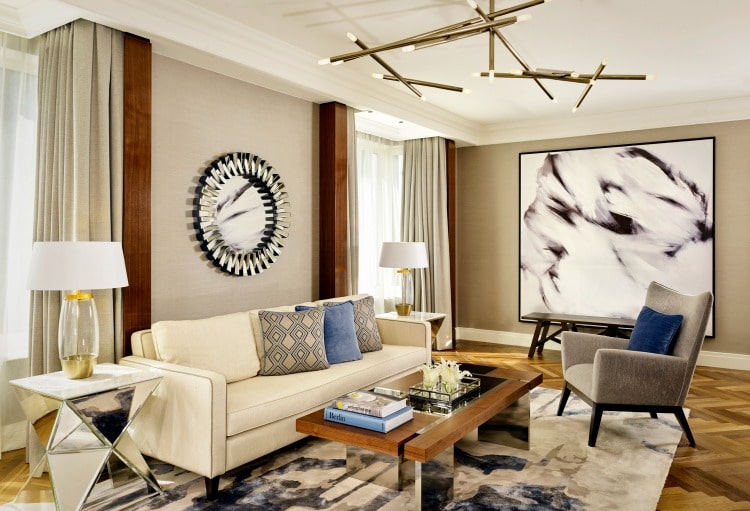
The Art of Cocktails and Perfumery
The hotel is known for its Curtain Club, a classic, paneled cocktail lounge hidden away from the bustling city on an upper floor, and The Lounge, renowned for high tea. But without a doubt it’s Fragrances, a bar where cocktails are combined with perfumes, that is most unique. “The Art of Cocktails and Perfumery” is its motto – get on board with it.
Arnd Henning Heissen, the bar manager, has created a cocktail list based on sensory experiences. Each drink presents an olfactory dimension tied to a popular perfume. While sipping your cocktail, you’re inhaling scents as part of the experience and there are spirits that match the scent that’s most appealing to you. This concept makes for terrific conversation if you go with friends as there’s literally nothing like it.
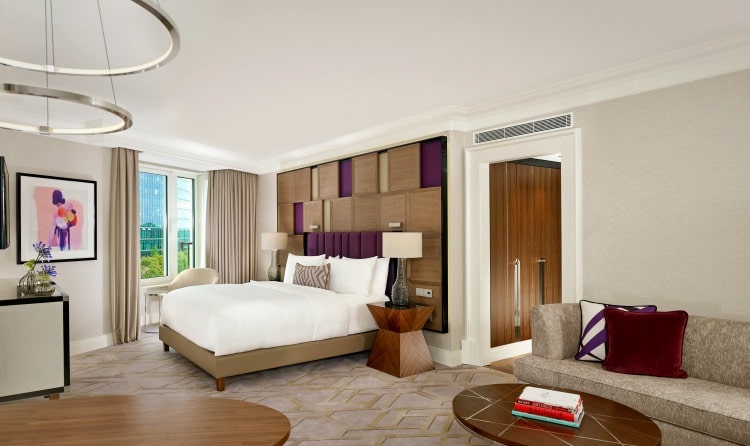
Dial C for Scandal
Berlin has been attracting artists and musicians from around the world for years, and the city is bursting with creative types, like Colette Lumiere, simply called Colette. A French-born American multimedia artist, Colette is known for her work exploring gender roles in performance art, street art and photography. An artist-in-residence at the Löwenpalais in Berlin, Colette knows her way around, and she wanted to show me the city’s cutting-edge venues and important historical sites.
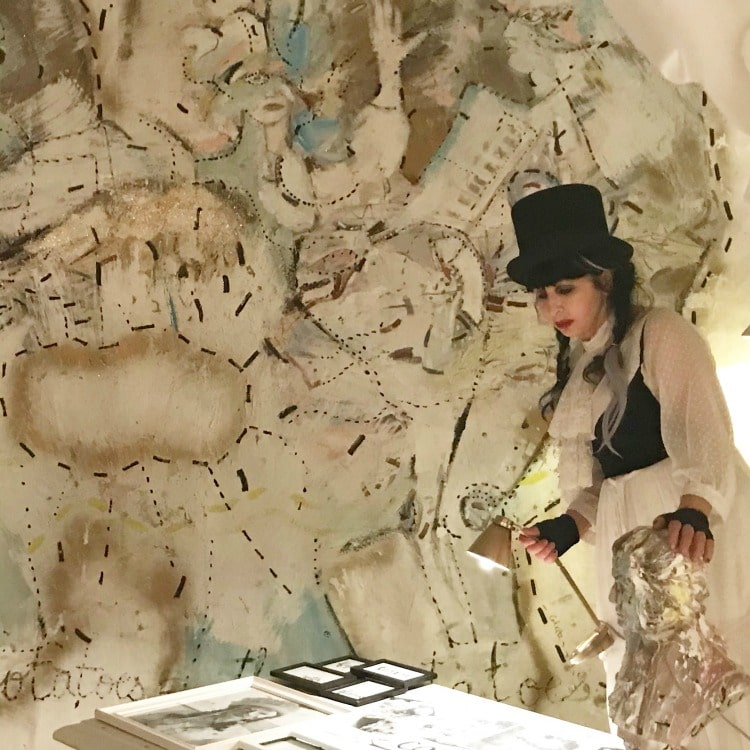
Gallery Crawl
We kicked off my Berlin weekend with a gallery crawl to check out the city’s vibrant art scene. First stop was the König Galerie. Housed in a former church, it’s one of Berlin’s major galleries. The wildly impressive structure is dominated by a cathedral height room where on this night we viewed an avant-garde video piece. Next was the Sprüth Magers Gallery where we saw a terrific installation by John Bock. The artist had created a series of African inspired forms and huts around the triple-height space. The artist, covered in tribal tattoos, hovered stories above us peering down and working on miniature artworks.
We continued our crawl at Seven Star Gallery, an edgy spot that is literally half underground. Earlier, there had been an avant-garde musical performance by Bob Rutman at a venue upstairs, and the gallery invited him to play afterward. His instruments, fashioned from string and sheets of tin, made mysterious, eerie sounds that filled the cavernous, candle-lit space. The gallery doubles as a bar, and a lively group gathered, talking art, music and design.
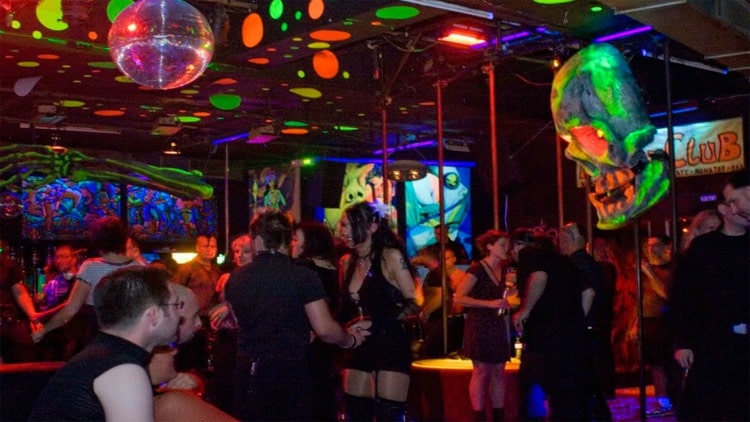
The KitKat Club
After fortifying ourselves with a little goulash at a charming local place, we decided it was time to brave the KitKat Club, renowned for its techno and trance music, and its, uh, uninhibited party atmosphere. To clarify, guests are permitted to engage in sex acts openly at this venue. And they do, but not me; I’m a voyeur to the core.
Opened in 1994 by Austrian pornographic filmmaker Simon Thaur and his partner, Kirsten Kruger, this place is named after the “Kit Kat Club” burlesque theater in the musical Cabaret.
Be advised there is a strict dress code and I don’t mean black tie. Patrons must wear leather, latex, fetish, kinky or just look gorgeous to get in. Tip: if you show up in street clothes, try ditching your shirt.
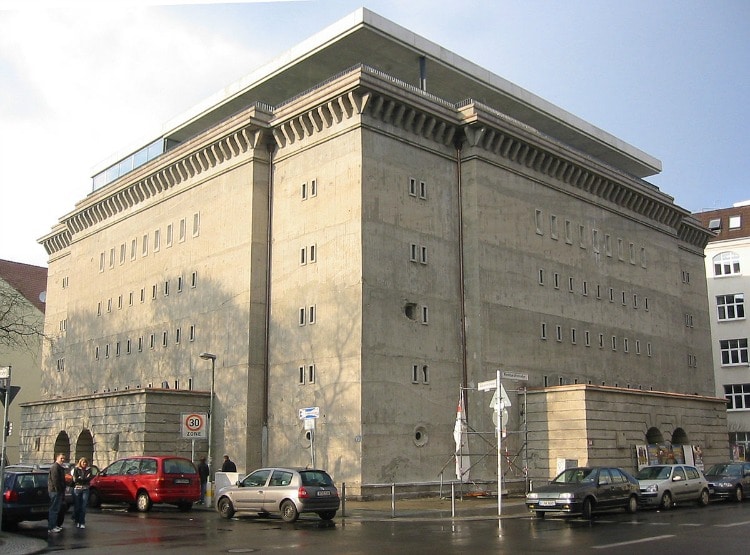
The Boros Bunker
On Saturday, we hit the Boros Bunker, a gallery in a former Nazi bunker that’s home to the Boros collection, founded by Christian and Karen Boros to showcase their contemporary art collection. While searching for the space, the Boros considered all kinds of abandoned spaces, including schools, hospitals and even swimming pools, and were so smitten when they found what they call “surely the ugliest building in Berlin” that they moved in. They now reside in a 5900-square-foot glass-walled apartment above the gallery.
You need an appointment to visit and the exhibition changes every four years. A tour, led by an extremely knowledgeable guide, takes 90 minutes and is definitely worth it. I participated in creating a work by sticking black tape from a large pile onto a mural, and later, made an artwork of a knife by stamping a paper with a wood block, an instant memento of Berlin and The Bunker.
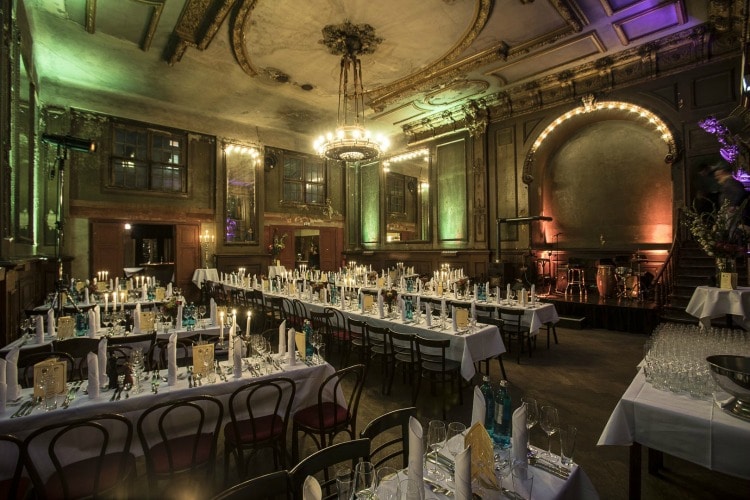
The Clärchens Ballroom
Afterward, we were starved and headed to Clärchens Ballroom. The Clärchens is an institution in Berlin, a restaurant where they stage concerts, everything from gypsy music to classical. Locals of all ages dance everything from the tango to the cha-cha. Built in 1913, it was rescued from the wrecking ball in 2005 by its current owners, who left it artfully faded, complete with chipped paint and cracked mirrors. Check out the piece de resistance, the mirrored ballroom upstairs. Later, we took a short walk down Bodestrasse, peering in the windows of a dozen galleries; this is Berlin’s SoHo.
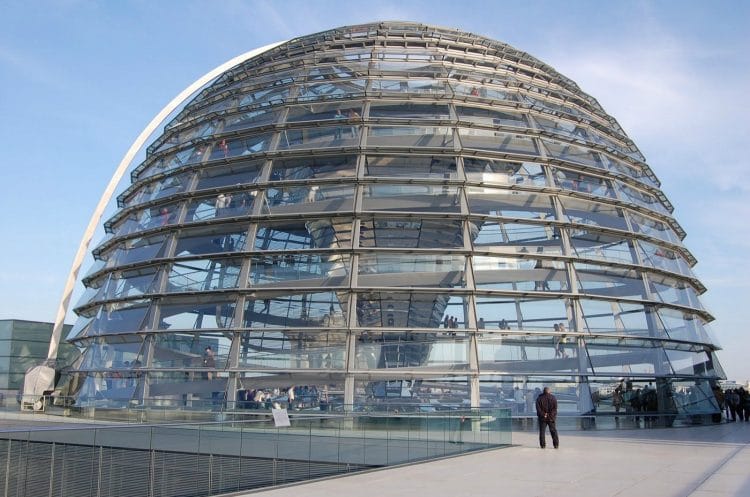
Museum Island
A side trip to Museum Island did not disappoint. Archaeologically monumental, the island contains five museums! Some of the buildings suffered damage during World War II and only reopened as recently as 2009. The entire complex is a UNESCO World Heritage site.
The Pergamon Museum is one of Germany’s most popular museums, and for good reason. Here you’ll find monumental buildings including an enormous altar that was likely part of a temple and the Ishtar Gate of Babylon, built by King Nebuchadnezzar in 575 BC. Dedicated to the goddess Ishtar, it was one of the original Seven Wonders of the World and was reconstructed here in 1930, using the original bricks.
Then it was on to the Neues Museum, where we found more ancient relics, this time from Egypt, including the iconic bust of Queen Nefertiti from 1345 BC. It is one of the most copied works of ancient Egypt, and that makes her one of the most famous women of the ancient world. And yes, it’s the subject of a longstanding dispute—Egypt wants it back.
Across the street is the huge Kaiser Wilhelm Memorial Church, a Berlin landmark. Hit by bombs during the war, the damaged spire remains, and the ground floor is now a memorial hall.
Checkpoint Charlie
As most visitors to Berlin do, I stopped at Checkpoint Charlie, the most-trafficked crossing point between East and West Berlin during the Cold War. After reunification, Checkpoint Charlie became a tourist attraction and is now located in the Allied Museum. We walked a few blocks to see what was left of the original Berlin Wall. That was pretty grim, but the tales of the ingenious ways that people escaped were impressive. My favorite was the girl who fit into two adjoining suitcases and entered West Berlin via train.

Soho House Berlin
Dinner that night was at SoHo House Berlin. The members-only club is situated in an imposing building that was originally a department store. In 1933, the store’s Jewish owners were pushed out, and the space became the headquarters of the Reich Youth Leadership organization. Today, members can choose from various dining options, the Club Bar, a screening room, fitness facility and spa, plus a rooftop bar, pool and kitchen. It’s also a hotel, offering 65 rooms, 20 apartments and four spacious lofts. A favorite of celebrities, the legendary Soho House discretion also applies in Berlin, lips—and phones—are sealed while on the premises. The club floors are warm and cozy. And I can attest, the roast chicken and champagne are delicious.
Berghain, The World’s Top Club
Once the clock struck 2 am we headed to Berghain, the top night club in the world which has a brutal door policy. Getting in was harder than getting into Studio 54 when it was at its pinnacle. But Colette’s glamorous friend Sasha, in black velvet opera cape, whisked us past two thousand freezing people right to the most beastly doorman on the planet, and voila we were in.
No exaggeration, this dance club is exclusive and “the skinhead door gods” aren’t even bribable. The Telegraph even assigned a reporter to write about the experience of getting in … not the club itself, just getting in. (The reporter didn’t make the grade after waiting forever in the cold. When the door staff told him to forget it, he asked why, and they said, “Because we decided”).

Holocaust Memorial
On Sunday, we went to the heartbreaking Holocaust Memorial, a memorial to the slaughtered Jews. This monumental gut-wrenching installation consists of more than 2,700 concrete slabs laid in a grid pattern on a sloping field. Resembling coffins, as you walk among the slabs, you feel immersed in a maze, a forest of stone. It is a profoundly moving experience. The memorial opened on May 10, 2005, 60 years after the end of WWII. There is an underground “Place of Information,” bearing the names of three million Holocaust victims.
Charlottenburg & Sanssouci Palaces
If you have a little extra time, the fabulously lavish Charlottenburg Palace is one of the top attractions. Dating from the 17th Century, its baroque interiors and formal gardens are stunning. The largest palace in Berlin, it was damaged during the war but has been meticulously restored.
Similarly, if you have a spare afternoon, take a 45-minute drive to see Sanssouci Palace, the summer home of Frederick the Great, which was built in 1745. It is so beautiful and is the German counterpart of Versailles.
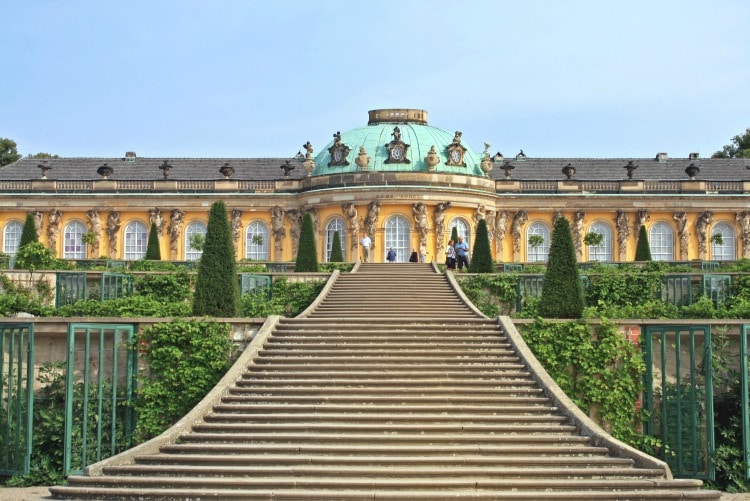
Brandenburg Gate & Reichstag Building
Be smart and have your concierge book a visit to the Reichstag, Berlin’s parliament, just to see the Norman Foster-designed dome. This glass space reminds me of the Guggenheim Museum with its spiral walkway overlooking the city’s monuments. The building was heavily damaged during World War II and was closed off by the Berlin Wall during the Cold War era. Artists Christo and Jean-Claude famously wrapped it in 1995, before reconstruction began, drawing millions of visitors.
Nearby is the Brandenburg Gate, one of Berlin’s most important sites, and a must-see. Built in 1791 by Prussian King Frederick William II, throughout history it has been home to historical events and became a symbol of post-war divided Germany when it was closed off by the Berlin Wall. Later, the gate became a symbol of the country’s reunification in 1990.
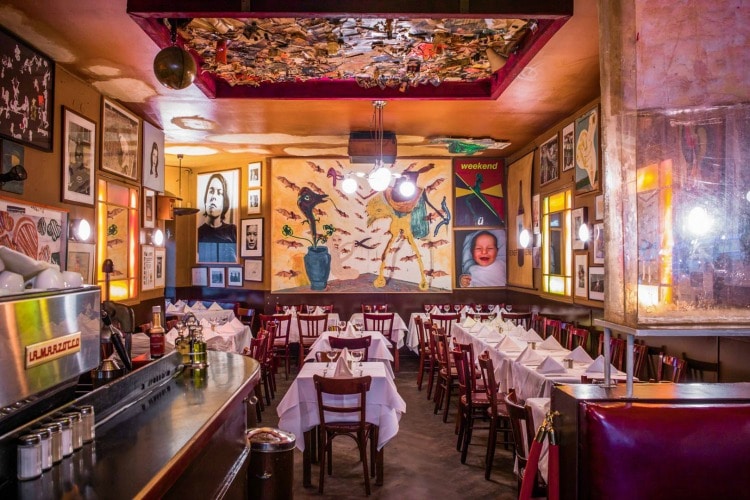
The Paris Bar & Café Einstein
One of the city’s artsy hot spots, this cozy boîte is as trendy as it looks, from the neon sign outside to the art-splashed interior. A hub for art, music and film, the Paris has attracted stars like David Bowie, Madonna and Iggy Pop over the years. Try the lamb chops or the bouillabaisse.
Another landmark is Café Einstein, one of the most beloved coffee houses in Berlin, housed in a building that miraculously survived the bombing that leveled the surrounding area. The food is great, and the strudel is out of this world.
The Löwenpalais, Starke Foundation Exhibitions
The Löwenpalais, a magnificent manor house built in 1903, has a storied history, and in 1930 was divided into flats for well-known actors and scientists of the era. Flash forward to 1987, when Jörg Peter Starke inherited the estate and founded the Starke Foundation. He invited artists to use the apartments as studios and began mounting exhibitions. The Löwenpalais quickly became a popular venue for art lovers.
My friend and Berlin tour guide, Colette, has an artist residency there. In her art-strewn studio, she has created one of her famous boudoir interiors. This magical space, draped in pale pink fabrics and tulle, houses sculptures and paintings including new works based on her recent African safari. She is open to private studio visits.

